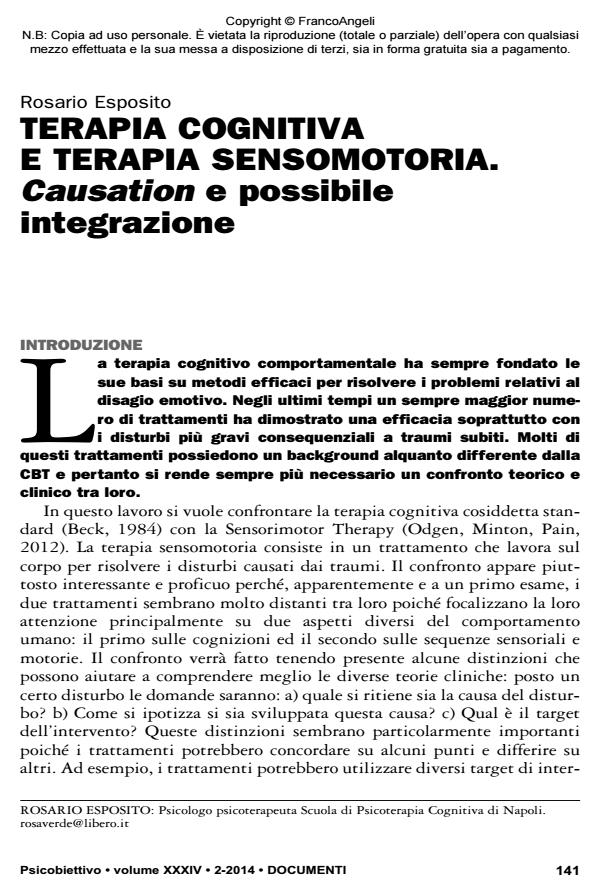Cognitive therapy and sensorimotor therapy. Causation and possible integration
Journal title PSICOBIETTIVO
Author/s Rosario Esposito
Publishing Year 2014 Issue 2014/2 Language Italian
Pages 13 P. 141-153 File size 550 KB
DOI 10.3280/PSOB2014-002010
DOI is like a bar code for intellectual property: to have more infomation
click here
Below, you can see the article first page
If you want to buy this article in PDF format, you can do it, following the instructions to buy download credits

FrancoAngeli is member of Publishers International Linking Association, Inc (PILA), a not-for-profit association which run the CrossRef service enabling links to and from online scholarly content.
Cognitive therapy has always had a very open approach to different clinical models provided, that proved to be effective. More and more frequently, in the international scene the clinical approaches are emerging which, although they demonstrate some effectiveness in treatments for mental health, they also appear theoretically very far from cognitive therapy and therefore difficult for clinical integration. This article seeks to compare cognitive therapy (Beck, 1984) with sensory motor therapy (Ogden et al., 2012) taking into account three key concepts that seem useful for understanding the normal and pathological behavior: the causation, ontogeny and the target of treatment. The comparison between the two approaches, thanks to the distinction above, lead to the emerging of individual differences, but also the individuation of unexpected and useful convergences that make an integration possible, which included the development of therapeutic strategies.
Keywords: Sensory Motor Psychotherapy, Cognitive Therapy; Psychotherapy Integration; Causation in Psychotherapy; Strategies in Psychotherapy
- Beck A. (1984) Principi di psicoterapia cognitiva, Astrolabio, Roma
- Beck A. (1990) L’amore non basta, Astrolabio, Roma
- Fosha D., Siegel D.J., Solomon M.F. (a cura di) (2011) Attraversare le emozioni, vol. I, Mimesis Edizioni, Milano-Udine
- Grigsby J., Stevens D. (2000) Neurodynamics of personality, Guilford Press, New York
- Lichtenberg J.D. (1990) “On motivational systems”, Journal of the American Psychoanalytic Association, 38(2): 517-518
- Liotti G. (1994) La dimensione interpersonale della coscienza, Carrocci, Roma
- Odgen P. (2011) “Emozioni, mindfulness e movimento. Espansione dei confini di regolazione della finestra di tolleranza affettiva”, in Fosha D., Siegel D.J., Solomon M.F. (a cura di), Attraversare le emozioni, vol. I, Mimesis Edizioni, Milano-Udine
- Ogden P., Minton K., Pain C. (2006) Trauma and the body. A sensorimotor approach to psychotheapy, Norton, New York (trad. it. Il trauma e il corpo. Manuale di psicoterapia sensomotoria, Edizioni Istituto di Scienze Cognitive, Sassari, 2012)
- Panksepp J. (1998) Affective neuroscience: The foundations of human and animal emotions, Oxford University Press, New York
- Porges S.W. (2011) “Reciproche Influenze Tra Corpo e Cervello nella Percezione ed Espressione degli Affetti: Una prospettiva Polivagale”, in Fosha D., Siegel D.J., Solomon M.F. (a cura di), Attraversare le emozioni, vol. I, Mimesis Edizioni, Milano-Udine
- Timbergen N. (1963) “On the aims and methods of ethology”, Zeitschrift für Tierpsychologie, 20(4): 410-433
- Van de Haart O., Nijenhuis E., Steele K. (2006) The haunted self: Structural dissociation and the treatment of cronic traumatization, Norton, New York (trad. it. Fantasmi del Sé: trauma e trattamento delle dissociazione strutturale, Raffaello Cortina, Milano 2011)
Rosario Esposito, Terapia cognitiva e terapia sensomotoria. causation e possibile integrazione in "PSICOBIETTIVO" 2/2014, pp 141-153, DOI: 10.3280/PSOB2014-002010